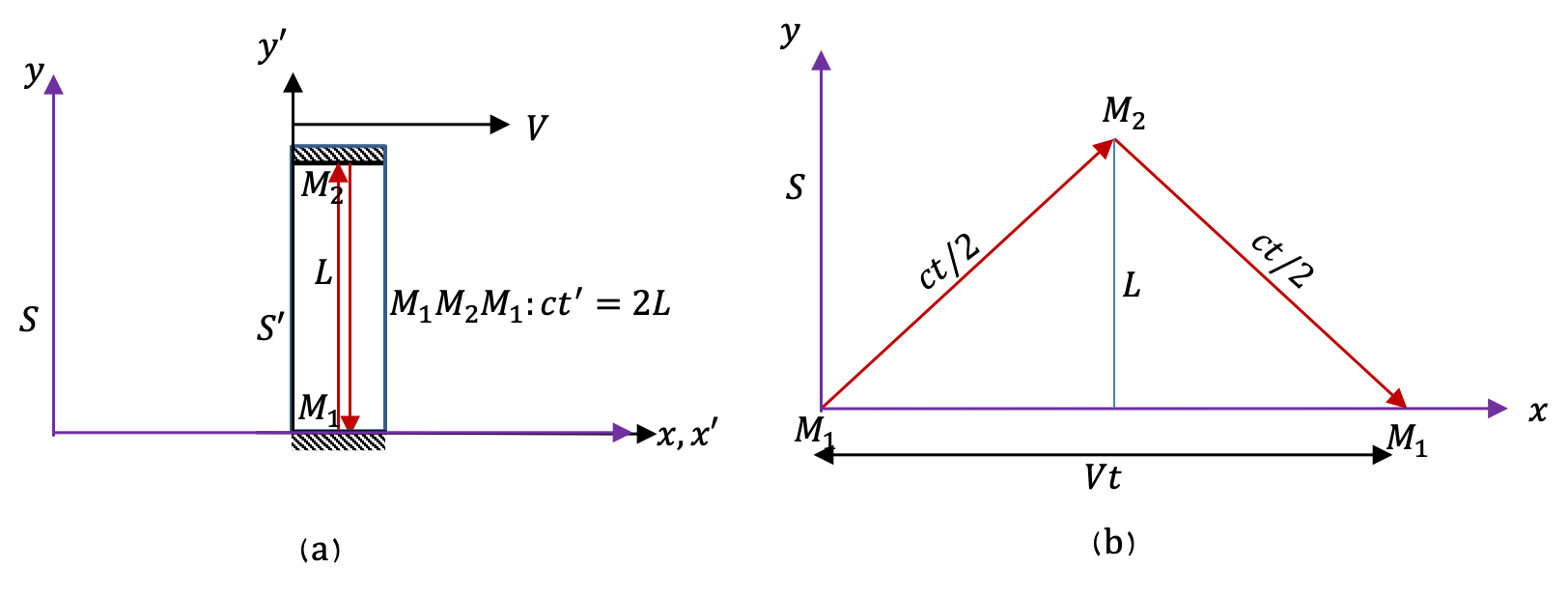This mystery can be understood if we examine the phenomenon of muon decay by special relativity. We consider two frames: the rest frame in which muon is at rest and the laboratory frame in which Earth is at rest. In the lab frame muon is moving towards Earth and in the rest frame Earth is moving towards the muon. The mystery of muon traveling all the way to Earth can be understood from the perspectives of the two frames as follows.
Perspective of Lab frame: Muon is traveling towards Earth at speed \(0.9999\: c\) and lives long enough to travel a distance of 15 km. In this perspective, the muon lifetime is dilated and lives longer than the lifetime of \(2.2\,\mu\text{s}\) in the rest frame.
Perspective of muon rest frame: Earth is traveling towards muon at speed \(0.9999\:c\) and in \(2.2\,\mu\text{s}\) the surface of the Earth to travels through the distance of thickness of the atmosphere. In this perspective, the thickness of the atmosphere is contracted and is less than \(15 \text{ km}\text{,}\) making it possible for the surface of Earth to travel a distance of the thickness of the atmosphere.
Now, let us work out the details of the two perspectives.
Lab Frame: The lifetime in the lab frame will be dilated with respect to the time in the rest frame by a factor of \(\gamma\text{,}\) which is
\begin{equation*}
\gamma = \frac{1}{\sqrt{1- V^2/c^2} }= \frac{1}{\sqrt{1- 0.9999^2} }= 70.7.
\end{equation*}
Therefore, the lifetime in the lab frame will be
\begin{equation*}
\Delta t_{\textrm{lab}} = \gamma\Delta t_{\textrm{rest}} = 70.7 \times 2.2\:\mu\textrm{s} = 156\:\mu\textrm{s} .
\end{equation*}
Now, in this frame the speed of muon is \(0.9999c\text{.}\) Therefore, the muon will travel a distance,
\begin{equation*}
\Delta x = 0.9999\:c \times \Delta t_{\textrm{lab}} = 46,795\:\textrm{m} > 15\:\textrm{km}.
\end{equation*}
Since \(\Delta x > 15\:\textrm{km}\) this muon will make it to the surface of Earth.
Muon Rest Frame: Let \(L_0\) be thickness of atmosphere in the Earth frame. We have been given \(L_0 = 15\) km. Now, from the perspective of the muon rest frame the length \(L_0\) will be contracted by a factor of \(\gamma\text{.}\) Therefore, the thickness of the atmosphere will be less in the muon rest frame.
\begin{equation*}
L = \frac{L_0}{\gamma} = \frac{15,000\:\textrm{m}}{70.7} = 212\:\textrm{m}.
\end{equation*}
Now, during the interval of 2.2 \(\mu\)s, the surface of Earth will move 660 m, which is more than the thickness of 220 m. Therefore, from the perspective of the muon rest frame, the muon will make it to the surface of Earth. Note that the two frames differ in the reason behind the fact that muon will arrive at the surface of Earth, but they agree on the fundamental physical observation that a muon created at 15 km above the surface of Earth and moving towards Earth at speed \(0.9999c\) will make it to the surface of Earth.



